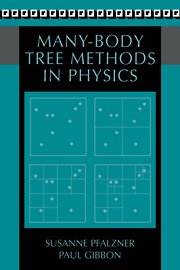Book contents
- Frontmatter
- Contents
- Preface
- Errata
- 1 Introduction
- 2 Basic Principles of the Hierarchical Tree Method
- 3 Open Boundary Problems
- 4 Optimisation of Hierarchical Tree Codes
- 5 Periodic Boundary Conditions
- 6 Periodic Boundary Problems
- 7 The Fast Multipole Method
- Appendix 1 Multipole Expansion in Two Dimensions
- Appendix 2 Spherical Harmonics
- Appendix 3 Near-Neighbour Search
- Refrences
- Index
3 - Open Boundary Problems
Published online by Cambridge University Press: 11 September 2009
- Frontmatter
- Contents
- Preface
- Errata
- 1 Introduction
- 2 Basic Principles of the Hierarchical Tree Method
- 3 Open Boundary Problems
- 4 Optimisation of Hierarchical Tree Codes
- 5 Periodic Boundary Conditions
- 6 Periodic Boundary Problems
- 7 The Fast Multipole Method
- Appendix 1 Multipole Expansion in Two Dimensions
- Appendix 2 Spherical Harmonics
- Appendix 3 Near-Neighbour Search
- Refrences
- Index
Summary
In this chapter we will present examples of so-called open boundary problems. By this we mean that the simulation contains all particles relevant to the problem, and the size of the simulation region is adjusted accordingly at each timestep. This type of problem is by far the easiest one to which one can apply hierarchical data structures. The additional difficulties posed by periodic boundaries will be considered in Chapters 5 and 6.
Gravitational Problems in Astrophysics
Hierarchical tree codes were first developed in the context of astrophysics. This is not surprising because there is a big discrepancy between the number of bodies one would like to study – for example, O (1011) for a galaxy – and the number one can afford to model with a standard N-body code – at present O(105). PIC codes, which employ a grid structure to represent the fields in space, usually cannot handle these problems for two reasons: the complex structure of the investigated object and the large density contrasts such as those found in galaxies. N-body codes are able to avoid the first of these difficulties, because they are gridless and can therefore cope with arbitrarily complicated structures. The second difficulty remains, however, because of the N2 scaling of computation time. This can have two consequences. If the number of simulation particles is too small, the spatial resolution of the simulation might not be good enough to reveal the real dynamic behaviour of the system.
- Type
- Chapter
- Information
- Many-Body Tree Methods in Physics , pp. 37 - 64Publisher: Cambridge University PressPrint publication year: 1996

